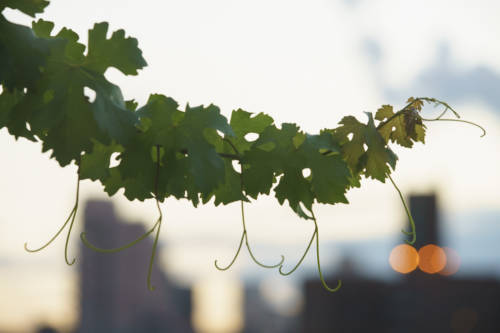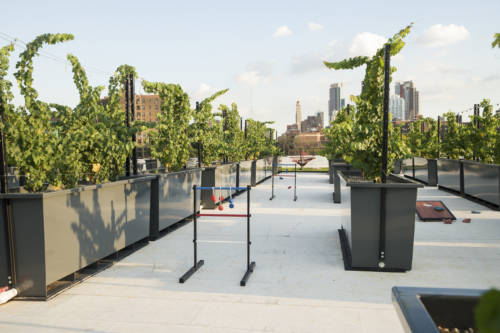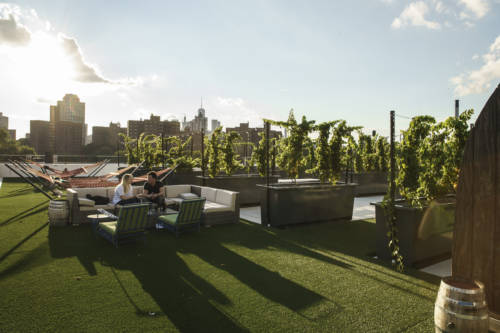
By Growing Their Grapes in Brooklyn, Rooftop Reds Is Shaping The Future of Urban Winemaking
Historically, many of the products which kept New York City satiated came from the city. New York City oysters were famous in their day. Although cows were not raised in New York, they were shipped here to be processed, turned into roasts and steaks in the (no longer accurately-named) meatpacking districts. In the landscape of urban food production, it was alcohol that was easiest to make within the city: pre-prohibition, the city had over 40 different breweries and 10% of American beer came from NYC.
In recent years, New Yorkers have become reacquainted with urban farming, from rooftop operations like Brooklyn Grange and massive factory operations like Gotham Greens, to restaurants installing vegetable gardens and private homes with windowsill herbs. The city is once again awash in breweries and distilleries. However, in the intervening years beer and liquor have acquired a rival on the shelves. American wine consumption has tripled, per capita, since WWII. However, much of that wine is still imported.
Adapting wineries to urban life is a little harder. Few breweries or distilleries own the fields that grow their hops, wheat, or rye. Instead, they source them from farmers, a multi-step process that can have its own problems. But, for vineyards, the vines are the heart of the product, often growing for hundreds of years. This presents a challenge for the potential urban winemaker. The obvious way around the need for established vines is to source the grapes from outside the city. One group, however, is trying to do something a little more ambitious by growing their own grapes in Brooklyn.
Rooftop Reds, as the name suggests, is a rooftop vineyard tucked away in the depths of the Brooklyn Navy Yard. It is quite possibly the only commercial rooftop vineyard in the world, its vines planted in neat rows– a bucolic picture in their custom made planters. The rooftop itself is beautiful, and for the Instagram set more than worth a trip– but what is truly interesting is the story of the vines.
Among the vines atop a four-story Navy Yard building is Cabernet Franc, the older sister of Cabernet Sauvignon. Cabernet Franc lives in the shadow of the younger wine. Historically, it is best known as part of the blend of wines that make up Bordeaux. In California, it’s planted mostly to be mixed, but because it lacks the pricing power, it’s mostly ignored for the more expensive Cabernet Sauvignon. However, recently, Cabernet Franc has come into fashion in various parts of the US, as it is more reliable than other red wine grapes and adapts well to cooler climates.
The expansion has paralleled the expansion of the definition of American wine. Rooftop Reds is an extreme example of a trend sweeping through U.S. viniculture. While California still produces the vast majority of American wine (85% of it as of 2015), the high price of land and concurrent drought have opened the door for other wine-producing regions to come to the fore. A number of regional styles have developed in Upstate New York, Virginia, and Colorado, to name just a few. These regions are producing winemakers with new and innovative ideas about what constitutes “good wine”– a contentious subject to begin with, and one whose answer will vary depending on who you ask.

Being younger than the legal drinking age did not stop co- founder Chris Papalia from completing his degree in viticulture.

"The best surprise was a visit from Jancis Robinson!" Founder Devin Shomaker said of a recent visit from the British wine critic and and advisor to Queen Elizabeth II's wine cellar.

While the rooftop vines mature, there are plenty of wine tasting options from New York's Finger Lakes region, where the founders got their start.

A birdseye view of Commodore Park, with downtown Brooklyn in the distance.
The two creators of Rooftop Reds, Devin Shomaker and Chris Papalia, are part of this new breed. They met in the viniculture and oenology program at The Finger Lakes Community College. Shomaker worked with various DC startups before he taking his life in a new direction while Papalia, one of the youngest wine makers in the US, has worked in various Finger Lakes wineries since he was a teen.
Chatting with them in the refurbished electrical room, now the Rooftop Reds Bar, the conversation is refreshingly straight forward and wine-focused. The wine world has changed over the past twenty-odd years. Young sommeliers are now more likely to sport tattoos and beards than business suits. Sometimes striving to be unpretentious can turn into being anti-pretentious, which is tiring in its own way. There was none of that, just two men who are passionate about making wine, and trying to expand the ideas that consumers have about what constitutes good wine.
It would be hard to find a more prototypically small business. Shomaker and Papalia are the only full time employees, working as bartenders, caretakers, as well as owners and winemakers. They host events, pizza and movie nights, bean bag toss tournaments, and an eclectic array of other activates.
In a city where everything is increasingly sterile and over-planned, this is a charming find. Rooftop Reds reminisces of a time when lower real estate prices allowed a wider range of people to experiment with art and business. Shomaker and Papalia evoke the first generation of craft brewers, people who left the establishment to start something new, with no idea that they would radically shift America’s taste in beer. I can’t say if New York City wine will ever achieve the level of success that New York City beer has, but at least now it has a chance.
While the nights are still temperate, step outside your comfort zone and try some wine that is not from the west coast or overseas. Check out the stunning sunset views. Most importantly, talk to the owners and enjoy your trip into their vision of the future.
For more information on Rooftop Reds, visit the company’s website.









































